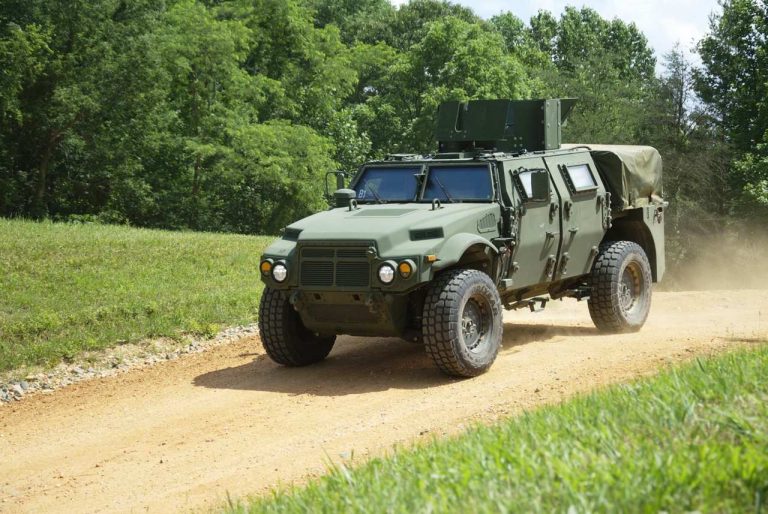Humvees, a name derived from the acronym for High Mobility Multipurpose Wheeled Vehicles, have been used by the military for more than 30 years. However, while the vehicles have long done troops proud, the changing face of modern warfare means that they are no longer the turnkey solution for military vehicles that they were when they debuted. Warfare has transformed in the years since the 1980s, reflecting a new age of asymmetrical battlefields based around counterinsurgency, terrorism, and assorted forms of irregular warfare. Two conflicts that epitomized this new type of warfare were the conflicts in Iraq and Afghanistan — although they are by no means isolated examples.
New ways of fighting mean new weapons, such as the potentially devastating rise in the use of IEDs (Improvised Explosive Devices). These have become widely used weapons, responsible for thousands of military deaths and injuries. As a result, armies have scrambled for ways to better protect their troops with new types of vehicles equipped for a new age of warfare. These vehicles must offer new features including underbelly blast protection and the ability to better absorb and deflect blasts, all while retaining the features that work so well, such as HMMWV seats and on- and off-road driving performance.
Contents
Get ready for the JLTV
This is where the Joint Light Tactical Vehicle (JLTV) enters the picture. In development for the past decade, the JLTV is a collaboration between the United States Army and the Marine Corps to create a successor to the aging Humvee. In August 2015, the Army awarded a $6.7 billion initial contract to Oshkosh, a U.S. industrial company that designs and builds specialty trucks, military vehicles, and more. The contract stipulated an initial procurement of almost 17,000 vehicles for both the Army and Marines. This would include two mission categories: the four-passenger JLTV Combat Tactical Vehicle and the two-passenger JLTV Combat Support Vehicle. Variants include General Purpose, Heavy Gun Carrier, Close Combat Weapon Carrier, and Utility Prime Mover versions, all capable of taking on different roles within the modern battlefield.
Earlier this year, Oshkosh was given the green light to start full-rate production. The entire program is estimated to be worth approximately $30 billion through 2024.
Troop protection is the order of the day
Protection comes first and foremost with the JLTV. The Humvee was developed at a time when concern about IEDs and other antivehicle explosives wasn’t a crucial component of military vehicle spec requirements. When it became apparent that this was a major threat, the Army made efforts to retrofit Humvees with extra armor plating, mainly on the sides. However, while this helped protect them against direct fire, it was by no means a flawless solution. The Humvee’s chassis wasn’t built to handle the extra weight, resulting in reduced reliability and off-road performance. Even more crucially, the Humvee offered minimal room to add underbody protection: the biggest necessity when protecting against IEDs.
The JLTV addresses this weakness by focusing on up-armoring to greatly improve vehicle survivability. The cabin is wrapped in armor, making it as impregnable as a vault (which just so happens to be on wheels). In addition to the side armor needed to protect against direct fire, its underside is also armored and designed in such a way that it channels the effects of blasts away from the vehicle. Fuel tanks are also armored, while neat features such as automated interior fire suppression equipment mean that troops are protected in a way they have never been before in a light vehicle.
Along with defenses, the JLTV’s configurable design also offers a range of firepower options depending on the model. This includes the integration of weapons such as a lightweight 30mm cannon paired with a 7.62 mm coaxial machine gun, multiple .50-caliber machine guns, lightweight automatic chain gun, and other weapon systems. This is not a primary offensive vehicle. But nor is it one that’s going to be unable to fend for itself should a combat scenario arise.
On- and off-road performance is exemplary
These aren’t the only things the JLTV has to offer. The Army has other vehicles capable of surviving IEDs and other explosive attacks, in addition to offering weaponry in war zones. But these have typically been heavier vehicles with the downsides that such vehicles come with. The JLTV offers comparable protection to the previous Mine Resistant Ambush Protected (MRAP) vehicles but is significantly lighter and more maneuverable. It is one-third lighter and 70% faster off-road than the MRAP. On-road, it boasts speeds of up to 70 miles per hour (110 km/h), while offering 20 inches of smart suspension travel for a ride that is more comfortable than many people would expect from a rugged military vehicle.
This won’t be the end of the Humvee. The vehicles will still be deployed by the Army for the foreseeable future. All involved have stressed that the JLTV is not a one-for-one replacement for the Humvee. But in everything from its ruggedized tough exterior, capable of dealing with the latest improvised explosive weapons, to its impressive on- and off-road performance, this is truly a military vehicle worthy of the 2020s.

